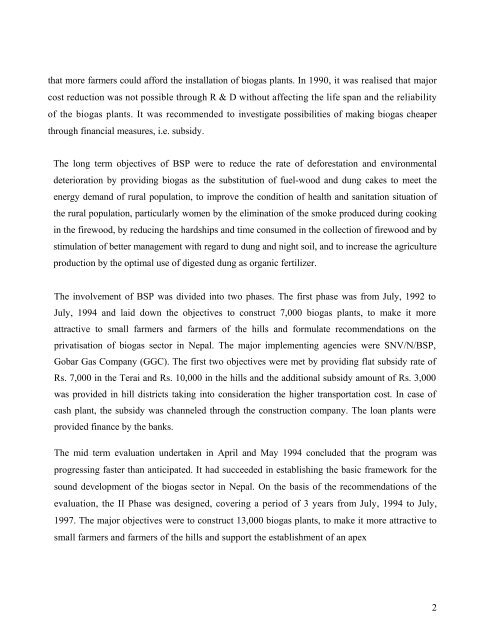download (pdf, 866kB) - SNV
download (pdf, 866kB) - SNV
download (pdf, 866kB) - SNV
You also want an ePaper? Increase the reach of your titles
YUMPU automatically turns print PDFs into web optimized ePapers that Google loves.
that more farmers could afford the installation of biogas plants. In 1990, it was realised that major<br />
cost reduction was not possible through R & D without affecting the life span and the reliability<br />
of the biogas plants. It was recommended to investigate possibilities of making biogas cheaper<br />
through financial measures, i.e. subsidy.<br />
The long term objectives of BSP were to reduce the rate of deforestation and environmental<br />
deterioration by providing biogas as the substitution of fuel-wood and dung cakes to meet the<br />
energy demand of rural population, to improve the condition of health and sanitation situation of<br />
the rural population, particularly women by the elimination of the smoke produced during cooking<br />
in the firewood, by reducing the hardships and time consumed in the collection of firewood and by<br />
stimulation of better management with regard to dung and night soil, and to increase the agriculture<br />
production by the optimal use of digested dung as organic fertilizer.<br />
The involvement of BSP was divided into two phases. The first phase was from July, 1992 to<br />
July, 1994 and laid down the objectives to construct 7,000 biogas plants, to make it more<br />
attractive to small farmers and farmers of the hills and formulate recommendations on the<br />
privatisation of biogas sector in Nepal. The major implementing agencies were <strong>SNV</strong>/N/BSP,<br />
Gobar Gas Company (GGC). The first two objectives were met by providing flat subsidy rate of<br />
Rs. 7,000 in the Terai and Rs. 10,000 in the hills and the additional subsidy amount of Rs. 3,000<br />
was provided in hill districts taking into consideration the higher transportation cost. In case of<br />
cash plant, the subsidy was channeled through the construction company. The loan plants were<br />
provided finance by the banks.<br />
The mid term evaluation undertaken in April and May 1994 concluded that the program was<br />
progressing faster than anticipated. It had succeeded in establishing the basic framework for the<br />
sound development of the biogas sector in Nepal. On the basis of the recommendations of the<br />
evaluation, the II Phase was designed, covering a period of 3 years from July, 1994 to July,<br />
1997. The major objectives were to construct 13,000 biogas plants, to make it more attractive to<br />
small farmers and farmers of the hills and support the establishment of an apex<br />
2
















